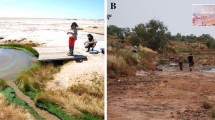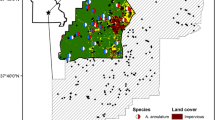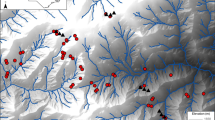Abstract
Dispersal distributions are often characterized by many individuals that stay close to their origin and large variation in the distances moved by those that leave. This variation in dispersal distance can strongly influence demographic, ecological, and evolutionary processes. However, a lack of data on the fitness and phenotype of individual dispersers has impeded research on the role of natural selection in maintaining variation in dispersal distance. Six years of spatially explicit capture-mark-recapture data showed that survival increased with dispersal distance in the stream salamander Gyrinophilus porphyriticus. To understand the evolutionary implications of this fitness response, we tested whether variation in dispersal distance has a phenotypic basis. We used photographs of marked individuals to measure head, trunk, and leg morphology. We then tested whether dispersal distances over the six-year study period were predicted by these traits. Dispersal distance was significantly related to leg morphology: individuals with relatively long forelimbs and short hindlimbs dispersed the farthest. These results support the hypothesis that positive fitness consequences maintain phenotypes enabling long-distance dispersal. More broadly, they suggest that natural selection can promote variation in dispersal distance and associated phenotypes, offering an alternative to the view that dispersal distance is driven by stochastic or landscape-specific mechanisms.


Similar content being viewed by others
References
Adams DC, Beachy CK (2001) Historical explanations of phenotypic variation in the plethodontid salamander Gyrinophilus porphyriticus. Herpetologica 57:353–364
Azizi E (2005) Biomechanics of salamander locomotion. PhD Dissertation, University of Massachusetts
Azizi E, Horton JM (2004) Patterns of axial and appendicular movements during aquatic walking in the salamander Siren lacertina. Zoology 107:111–120
Baumgartner N, Waringer A, Waringer J (1999) Hydraulic microdistribution patterns of larval fire salamanders (Salamandra salamandra salamandra) in the Weidlingbach near Vienna, Austria. Freshw Biol 41:31–41
Benard MF, McCauley SJ (2008) Integrating across life-history stages: consequences of natal habitat effects on dispersal. Am Nat 171:553–567
Bennett AF, Garland T, Else PL (1989) Individual correlation of morphology, muscle mechanics, and locomotion in a salamander. Am J Physiol 256:R1200–R1208
Bernatchez L, Duchesne P (2000) Individual-based genotype analysis in studies of parentage and population assignment: how many loci, how many alleles? Can J Fish Aquat Sci 57:1–12
Bonte D, Travis JMJ, De Clercq N, Zwertvaegher I, Lens L (2008) Thermal conditions during juvenile development affect adult dispersal in a spider. Proc Natl Acad Sci USA 105:17000–17005
Bookstein FL (1989) “Size and shape”: a comment on semantics. Syst Zool 38:173–180
Brandon RA (1966) Systematics of the salamander genus Gyrinophilus. The University of Illinois Press, Urbana
Brodie ED, Nowack RT, Harvey WR (1979) The effectiveness of antipredator secretions and behavior of selected salamanders against shrews. Copeia 1979:270–274
Bruce RC (1980) A model of the larval period of the spring salamander, Gyrinophilus porphyriticus, based on size-frequency distributions. Herpetologica 36:78–86
Burton TM (1976) An analysis of feeding ecology of the salamanders (Amphibia: Urodela) of the Hubbard Brook Experimental Forest, New Hampshire. J Herpetol 10:187–204
Carlquist S (1981) Chance dispersal. Am Sci 69:509–516
Carroll RL, Kuntz A, Albright K (1999) Vertebral development and amphibian evolution. Evol Dev 1:36–48
Caswell H, Lensink R, Neubert MG (2003) Demography and dispersal: life table response experiments for invasion speed. Ecology 84:1968–1978
Clark ME, Martin TE (2007) Modeling tradeoffs in avian life history traits and consequences for population growth. Ecol Model 209:110–120
Clobert J, Danchin E, Dhondt AA, Nichols JD (eds) (2001) Dispersal. Oxford University Press, Oxford
Clobert J, Le Galliard JF, Cote J, Meylan S, Massot M (2009) Informed dispersal, heterogeneity in animal dispersal syndromes and the dynamics of spatially structured populations. Ecol Lett 12:197–209
D’Aout K, Aerts P (1999) A kinematic comparison of forward and backward swimming in the eel Anguilla anguilla. J Exp Biol 202:1511–1521
Darwin C (1859) The origin of species by means of natural selection. John Murray, London
Dobzhansky T, Wright S (1943) Genetics of natural populations. X. Dispersal rates in Drosophila pseudoobscura. Genetics 28:304–340
Doebeli M, Ispolatov I (2010) Complexity and diversity. Science 328:494–497
Duckworth RA, Badyaev AV (2007) Coupling of dispersal and aggression facilitates the rapid range expansion of a passerine bird. Proc Natl Acad Sci USA 104:15017–15022
Duellman WE, Trueb L (1986) Biology of amphibians. McGraw-Hill, New York
Dytham C (2009) Evolved dispersal strategies at range margins. P R Soc B 276:1407–1413
Endler JA (1977) Geographic variation, speciation and clines. Princeton University Press, Princeton
Endler JA (1986) Natural selection in the wild. Princeton University Press, Princeton
Finos L, Brombin C, Salmaso L (2010) Adjusting stepwise p-values in generalized linear models. Communications in Statistics-Theory and Methods 39:1832–1846
Fraser DF, Gilliam JF, Daley MJ, Le AN, Skalski GT (2001) Explaining leptokurtic movement distributions: intrapopulation variation in boldness and exploration. Am Nat 158:124–135
Freeman S, Herron JC (2001) Evolutionary analysis. Prentice Hall, Upper Saddle River
Friedenberg NA (2003) Experimental evolution of dispersal in spatiotemporally variable microcosms. Ecol Lett 6:953–959
Fryxell JM, Hazell M, Borger L et al (2008) Multiple movement modes by large herbivores at multiple spatiotemporal scales. Proc Natl Acad Sci USA 105:19114–19119
Futuyma DJ (2005) Evolution. Sinauer Associates, Sunderland
Gallant N, Teather K (2001) Differences in size, pigmentation, and fluctuating asymmetry in stressed and nonstressed northern leopard frogs (Rana pipiens). Ecoscience 8:430–436
Gillis GB (1996) Undulatory locomotion in elongate aquatic vertebrates: anguilliform swimming since Sir James Gray. Am Zool 36:656–665
Graham MH (2003) Confronting multicollinearity in ecological multiple regression. Ecology 84:2809–2815
Grant EHC (2008) Visual implant elastomer mark retention through metamorphosis in amphibian larvae. J Wildl Manag 72:1247–1252
Grant EHC, Nichols JD, Lowe WH, Fagan WF (2010) Use of multiple dispersal pathways facilitates amphibian persistence in stream networks. Proc Natl Acad Sci USA 107:6936–6940
Gray J (1968) Animal locomotion. W.W. Norton and Co., New York
Green AJ (2001) Mass/length residuals: measures of body condition or generators of spurious results? Ecology 82:1473–1483
Greene BT, Lowe WH, Likens GE (2008) Forest succession and prey availability influence the strength and scale of terrestrial-aquatic linkages in a headwater salamander system. Freshw Biol 53:2234–2243
Harrison RG (1980) Dispersal polymorphisms in insects. Annu Rev Ecol Syst 11:95–118
Hastings A (1977) Spatial heterogeneity and the stability of predator-prey systems. Theor Popul Biol 12:37–48
Heyer WR, Donnelly MA, McDiarmid RW, Hayek LC, Foster MS (1994) Measuring and monitoring biodiversity: standard methods for amphibians. Smithsonian Institution Press, Washington
Higgins SI, Richardson DM (1999) Predicting plant migration rates in a changing world: the role of long-distance dispersal. Am Nat 153:464–475
Ims RA, Hjermann DO (2001) Condition-dependent dispersal. In: Clobert J, Danchin E, Dhondt AA, Nichols JD (eds) Dispersal. Oxford University Press, Oxford, pp 203–216
Johnson ML, Gaines MS (1990) Evolution of dispersal: theoretical models and empirical tests using birds and mammals. Annu Rev Ecol Syst 21:449–480
Johnson CA, Fryxell JM, Thompson ID, Baker JA (2009) Mortality risk increases with natal dispersal distance in American martens. Proc R Soc B 276:3361–3367
Jungers WL, Falsetti AB, Wall CE (1995) Shape, relative size, and size-adjustments in morphometrics. Yearb Phys Anthropol 38:137–161
Kimura M (1955) Stochastic processes and distribution of gene frequencies under natural selection. Cold Spring Harbor Symp Quant Biol 20:33–53
Kleinbaum DG, Kupper LL, Muller KE, Nizam A (1998) Applied regression analysis and other multivariate models. Duxbury Press, Pacific Grove
Koenig WD (1999) Spatial autocorrelation of ecological phenomena. Trends Ecol Evol 14:22–26
Koenig WD, VanVuren D, Hooge PN (1996) Detectability, philopatry, and the distribution of dispersal distances in vertebrates. Trends Ecol Evol 11:514–517
Levin SA, Muller-Landau HC, Nathan R, Chave J (2003) The ecology and evolution of seed dispersal: a theoretical perspective. Annu Rev Ecol Evol Syst 34:575–604
Lewontin RC (1974) The genetic basis of evolutionary change. Columbia University Press, New York
Likens GE, Bormann FH (1995) Biogeochemistry of a forested ecosystem. Springer, New York
Lowe WH (2003) Linking dispersal to local population dynamics: a case study using a headwater salamander system. Ecology 84:2145–2154
Lowe WH (2009) What drives long-distance dispersal? A test of theoretical predictions. Ecology 90:1456–1462
Lowe WH (2010) Explaining long-distance dispersal: effects of dispersal distance on survival and growth in a stream salamander. Ecology 91:3008–3015
Lowe WH, Allendorf FW (2010) What can genetics tell us about population connectivity? Mol Ecol 19:3038–3051
Lowe WH, Nislow KH, Bolger DT (2004) Stage-specific and interactive effects of sedimentation and trout on a headwater stream salamander. Ecol Appl 14:164–172
Lowe WH, Likens GE, Cosentino BJ (2006) Self-organisation in streams: the relationship between movement behaviour and body condition in a headwater salamander. Freshw Biol 51:2052–2062
Mayr E (1963) Animal species and evolution. Harvard University Press, Cambridge
Morales JM (2002) Behavior at habitat boundaries can produce leptokurtic movement distributions. Am Nat 160:531–538
Morales JM, Haydon DT, Frair J, Holsiner KE, Fryxell JM (2004) Extracting more out of relocation data: building movement models as mixtures of random walks. Ecology 85:2436–2445
Morris DW (1992) Scales and costs of habitat selection in heterogeneous landscapes. Evol Ecol 6:412–432
Nathan R (2001) The challenges of studying dispersal. Trends Ecol Evol 16:481–483
Nathan R (2005) Long-distance dispersal research: building a network of yellow brick roads. Divers Distrib 11:125–130
Nathan R (2006) Long-distance dispersal of plants. Science 313:786–788
Noble GK (1954) The biology of the Amphibia. Dover Publications, New York
Orzack SH, Sober E (2001) Adaptationism and optimality. Cambridge University Press, Cambridge
Petranka JW (1998) Salamanders of the United States and Canada. Smithsonian Institution Press, Washington
Petrovskii S, Morozov A (2009) Dispersal in a statistically structured population: fat tails revisited. Am Nat 173:278–289
Phillips BL, Brown GP, Webb JK, Shine R (2006) Invasion and the evolution of speed in toads. Nature 439:803
Pollock KH (2002) The use of auxiliary variables in capture-recapture modelling: an overview. J Appl Stat 29:85–102
Pollock KH, Nichols JD, Simons TR et al (2002) Large scale wildlife monitoring studies: statistical methods for design and analysis. Environmetrics 13:105–119
Pulliam HR, Danielson BJ (1991) Sources, sinks, and habitat selection: a landscape perspective on population dynamics. Am Nat 137:S50–S66
Roff DA (2002) Life history evolution. Sinauer Associates, Sunderland
Ronce O (2007) How does it feel to be like a rolling stone? Ten questions about dispersal evolution. Annu Rev Ecol Evol Syst 38:231–253
Rose MR, Lauder GV (1996) Adaptation. Academic Press, San Diego
Rousset F, Gandon S (2002) Evolution of the distribution of dispersal distance under distance-dependent cost of dispersal. J Evol Biol 15:515–523
Semlitsch RD (2008) Differentiating migration and dispersal processes for pond-breeding amphibians. J Wildl Manag 72:260–267
Shine R, Brown GP, Phillips BL (2011) An evolutionary process that assembles phenotypes through space rather than through time. Proc Natl Acad Sci USA 108:5708–5711
Simmons AD, Thomas CD (2004) Changes in dispersal during species’ range expansions. Am Nat 164:378–395
Skalski GT, Gilliam JF (2003) A diffusion-based theory of organism dispersal in heterogeneous populations. Am Nat 161:441–458
Sorensen AE (1978) Somatic polymorphism and seed dispersal. Nature 276:174–176
St-Amour V, Garner TWJ, Schulte-Hostedde AI, Lesbarreres D (2010) Effects of two amphibian pathogens on the developmental stability of green frogs. Conserv Biol 24:788–794
Stamps JA, Krishnan VV, Reid ML (2005) Search costs and habitat selection by dispersers. Ecology 86:510–518
Suarez AV, Holway DA, Case TJ (2001) Patterns of spread in biological invasions dominated by long-distance jump dispersal: insights from Argentine ants. Proc Natl Acad Sci USA 98:1095–1100
Taylor TB, Buckling A (2010) Competition and dispersal in Pseudomonas aeruginosa. Am Nat 176:83–89
Tittler R, Fahrig L, Villard MA (2006) Evidence of large-scale source-sink dynamics and long-distance dispersal among wood thrush populations. Ecology 87:3029–3036
Triantafyllou MS, Triantafyllou GS, Yue DKP (2000) Hydrodynamics of fishlike swimming. Ann Rev Fluid Mech 32:33–53
Tufto J, Engen S, Hindar K (1997) Stochastic dispersal processes in plant populations. Theor Popul Biol 52:16–26
Turchin P (1998) Quantitative analysis of movement. Sinauer Associates, Sunderland
Van Houtan KS, Pimm SL, Halley JM, Bierregaard RO, Lovejoy TE (2007) Dispersal of Amazonian birds in continuous and fragmented forest. Ecol Lett 10:219–229
White GC, Burnham KP (1999) Program MARK: survival estimation from populations of marked animals. Bird Study 46:120–139
Wright S (1951) The genetical structure of natural populations. Ann Eugen 15:323–354
Zar JH (1984) Biostatistical analysis. Prentice-Hall, Englewood Cliffs
Acknowledgments
This research was funded by the Sweet Water Trust, the National Science Foundation (DEB-0105091 and DEB-0714782), and the Andrew W. Mellon Foundation. We are grateful for support from L. Turner, K. Evans, L. Greene, C. Shannon, C. Glastris, A. Margolis, B. Fisher, J. Tollefson, W. Lowe, and I. Lowe. This manuscript was improved with comments from B. Addis, M. Wilson, and B. Hossack.
Author information
Authors and Affiliations
Corresponding author
Rights and permissions
About this article
Cite this article
Lowe, W.H., McPeek, M.A. Can natural selection maintain long-distance dispersal? Insight from a stream salamander system. Evol Ecol 26, 11–24 (2012). https://doi.org/10.1007/s10682-011-9500-z
Received:
Accepted:
Published:
Issue Date:
DOI: https://doi.org/10.1007/s10682-011-9500-z




